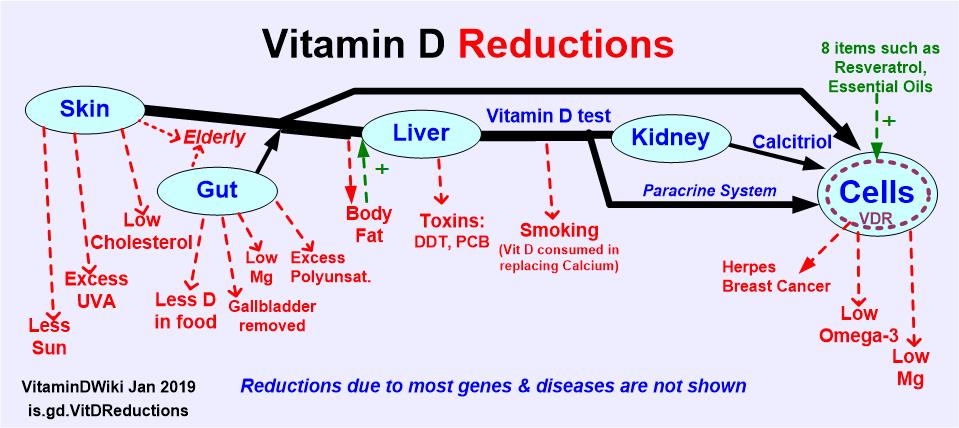Simple Vitamin D deficiency scoring system
Quick and Easy Screening for Vitamin D Insufficiency in Adults: A Scoring System to Be Implemented in Daily Clinical Practice.
Medicine (Baltimore). 2016 Feb;95(7):e2783. doi: 10.1097/MD.0000000000002783.
Deschasaux M1, Souberbielle JC, Andreeva VA, Sutton A, Charnaux N, Kesse-Guyot E, Latino-Martel P, Druesne-Pecollo N, Szabo de Edelenyi F, Galan P, Hercberg S, Ezzedine K, Touvier M.
1From the Sorbonne Paris Cité Epidemiology and Statistics Research Center (CRESS) (MD, VAA, EK-G, PL-M, ND-P, FSdE, PG, SH, KE, MT), Nutritional Epidemiology Research Team (EREN), Inserm U1153, Inra U1125, Cnam, Paris 13 University, Bobigny; Department of Physiology (J-CS), Necker Hospital, Inserm U845, Paris; Jean Verdier Hospital, Biochemistry Department (AS, NC), Inserm U698, Paris 13 University, Bondy; Public Health Department (SH), Avicenne Hospital, Bobigny; and Dermatology Department (KE), Henri Mondor Hospital, Paris, France.
moderate sun exposure, very fair or dark skin || 2 | latitude ≥48°N and spring season || 2.5 | obesity and late winter || 3 | low sun exposure || | || --- | --- || Total points | < 20 ng || 7 | 70% || >9 | 80% |Their simple system does not consider the followingLow magnesium, smoking, cola drinks, low cholesterol in diethealth problems which consume Vitamin DExcessive UVA (thru windows, late afternoont)Poor gut, DDT, Excessive Vitamin A, Gall bladder removedTake drug which consumes of blocks Vitamin DAge - reduced vitamin D from gut and from skin, reduced stomach acidPregnancy, Excessive clothing, Poor Kidney. Low Omega-3Roundup in food, Night shift. Born in winter. GenesSee Vitamin D Life* Is 50 ng of vitamin D too high, just right, or not enough* Predict Vitamin D **category listing has items along with related searches** * Model has 80 percent chance of predicting vitamin D levels to within 10 ng – Feb 2012* Toward predicting vitamin D levels without a blood test.* Higher air pollution associated with 7 ng lower vitamin D levels – Aug 2013* Free Vitamin D evaluation service* Molecular Approaches for Optimizing Vitamin D (one size does not fit all) – Carlberg Nov 2015* 43 reasons for Vitamin D deficiency* Vitamin D Deficiency* Reasons for low response to vitamin D which has the following

📄 Download the PDF from Vitamin D Life


Vitamin D is essential regarding several health outcomes. Prevention of insufficiency (25-hydroxyvitamin D concentration ≤20 ng/mL) generally entails blood testing and/or supplementation, strategies that should target at-risk individuals because blood testing is costly, and unwarranted supplementation could result in vitamin D overload with unknown long-term consequences.Our objective was to develop a simple score (Vitamin D Insufficiency Prediction score, VDIP) for identifying adults at risk of vitamin D insufficiency.Subjects were 1557 non-vitamin D-supplemented middle-aged adults from the SU.VI.MAX cohort. Scoring points corresponded to the rounded odds ratio for each individual-level characteristic associated with vitamin D insufficiency in a multivariable logistic regression model. Receiver operating characteristic curve (area under curve), sensitivity, specificity, and positive and negative predictive values were computed. External validation was performed in an independent cohort (NutriNet-Santé, N = 781).For female sex, overweight, low physical activity, winter season, moderate sun exposure, and very fair or dark skin 1.5 points were attributed; 2 points for latitude ≥48°N and spring season; 2.5 points for obesity and late winter; 3 points for low sun exposure. Points were then summed up for each participant. The VDIP score had an AUC = 0.70 ± 0.01 (validation: 0.67 ± 0.02). With a score of 7 or more, 70% of the participants were vitamin D-insufficient (80% in those with a score ≥9), sensitivity/specificity were 0.67/0.63, and positive and negative predictive values were 0.70/0.59. The VDIP score performed well in identifying middle-aged adults at risk of vitamin D insufficiency (score ≥7, moderate risk; score≥9, high risk), using only simple individual-level characteristics easily assessable in day-to-day clinical practice. Implementation of this simple and costless score could thus obviate unwarranted supplementation and/or blood testing.
PMID: 26886626
